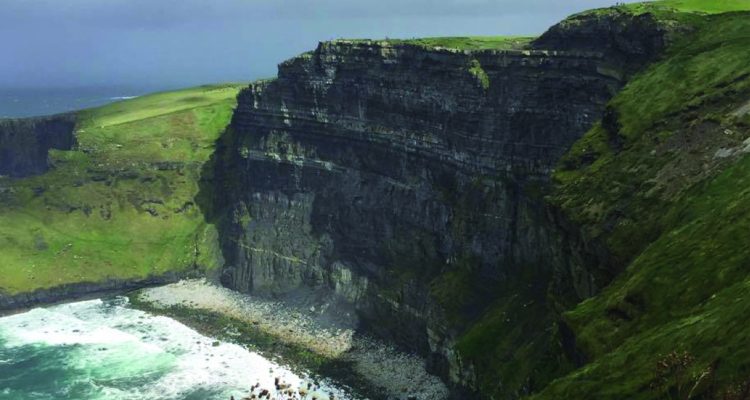When our bus pulled up to the Cliffs of Moher, it was so windy that the top of the bus was buffeting. I looked out the window and saw people’s coats blowing wildly, and the grass whipping back and forth. The bus driver advised us all to go up to the cliffs first because the weather was only going to get worse. Obviously, I was about half-convinced that I would be blown off the almost 400-foot tall cliffs and into the Atlantic Ocean below.
We walked up from the parking lot to the clifftop, where a stone wall separated tourists from the edge. I was totally awestruck when I looked over the cliff face and down at the water below, despite my scarf and hair blowing into my face and how cold it was at the edge. Signs posted by the Irish government advised people that they went past the wall at their own risk.
The Cliffs of Moher are incredible. The striking view of the rocky cliffs was immediately inspiring. Below us, the sea churned white from the wind and crashed against the rocks. The cows of local farmers hunkered in fields, utterly — no pun intended — unconcerned by the weather and all of the people watching the cliffs. As soon as I saw them, I understood why the cliffs are one of the most popular tourist sites in Ireland. I had never seen anything quite like it before. The cliffs are so distinct that they may be the only natural formation exactly like this in the world. Not only are they a major tourist attraction and a shooting site for “The Princess Bride,” the Cliffs of Moher are incredibly beautiful. Similarly to Niagara Falls or the Grand Canyon, you’re very aware that you are looking at something extremely unique.
I felt small and inspired, and a part of a world that is bigger than myself. I felt lucky to be allowed to look at the cliffs, with all of these people and lucky to be abroad for an entire semester. The Irish Times reports that one million people visit the Cliffs of Moher every year and I got to be one of those people — a drop in the statistical bucket. The Cliffs of Moher are a landmark that has been part of the Irish coastline for roughly 300 million years and will be here for millions of years after we’re gone. I stood where literally millions of other people have stood, at a landmark constructed by nature, for just a few minutes. It was impossible for me to not feel inspired.
After seeing enough of the cliffs in the freezing wind, we ducked into the visitor’s center at the bottom of the hill, with pictures of the cliffs in all seasons as well as the colony of puffins that makes its home there. It was when I was in the visitor’s center that the Cliffs of Moher staff broadcasted: “We now advise that due to the weather, you do not go up to the cliff’s edge.”
Luckily, no Fairfield students were blown off.


Leave a Reply